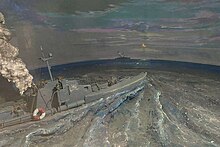KRI Matjan Tutul
 KRI Matjan Tutul replica
| |
| History | |
|---|---|
| Builder | Lurssen, Bremen-Vegesack |
| Commissioned | 1957 |
| Out of service | 1960 |
| Fate | Sold to the Indonesian Navy in 1960 |
| Name | Matjan Tutul |
| Acquired | 1960 |
| Commissioned | 1961 |
| Identification | 602 |
| Fate | Sunk on 15 January 1962 |
| General characteristics | |
| Class and type | Jaguar-class fast attack craft |
| Displacement | |
| Length | 42.60 m (139 ft 9 in) |
| Beam | 7.10 m (23 ft 4 in) |
| Draught | 2.30 m (7 ft 7 in) |
| Propulsion |
|
| Speed |
|
| Range | 700 nmi (1,300 km; 810 mi) at 35 knots (65 km/h; 40 mph) |
| Complement | 39 officers and enlisted |
| Sensors and processing systems | Navigation radar, surveillance radar |
| Armament | |
KRI Matjan Tutul was one of eight Jaguar-class torpedo boats operated by the Indonesian Navy, that were built in West Germany in the 1960s. Renowned for its speed and advanced torpedo systems, the vessel played a role in protecting Indonesia's waters during the Battle of Arafura Sea, one of several battles during Operation Trikora.
Design
[edit]Matjan Tutul was one of the eight fast attack craft (FAC) purchased by Indonesia from West Germany in 1960, the FACs was part of the Indonesian Navy's first generation of fast attack craft. By 1961 two of the eight FACs purchased had participated in naval combat exercises; Matjan Tutul and KRI Adjak. Matjan Tutul was manned by 39 crew members, including 4 officers, 2 cooks, 17 engine room personnel, and 18 sailors.
Matjan Tutul measured 42.6 metres (139 ft 9 in) in length with a beam of 7.1 metres (23 ft 4 in) with a displacement of 183.4 tonnes (180.5 long tons) and a sleek design, Matjan Tutul embodied both power and agility. Despite its simple appearance, the ship proved formidable and swift. It was powered by four Mercedes-Benz MB51B diesel engines producing 3,000 horsepower (2,200 kW). True to its designation as a fast attack craft, it could reach speeds, propelled by four 1.15-metre (3 ft 9 in)-diameter propellers, enabling the ship to sail at a maximum speed of 42 knots (78 km/h; 48 mph).[1]
Weaponry
[edit]Matjan Tutul was equipped with various weaponry including two Bofors 40-millimetre (1.6 in) guns mounted on both the bow and stern, and was supposed to be equipped with four 533 mm (21.0 in) torpedo tubes, with two mounted on each side of the vessel. However, due to the restrictions imposed on West Germany as part of their agreement with the Allies, they were prohibited from producing torpedoes.
The Indonesian government then planned to acquire the MK 3 torpedoes from the United Kingdom. However, due to the United Kingdom's alliance with the Netherlands, which was opposed to Indonesia's independence, they refused to sell the torpedoes to Indonesia. As a result, Indonesia then ordered torpedoes from the Soviet Union. However, when Operation Trikora was declared, the weaponry had not yet arrived in Indonesia. Despite this, the Jaguar-class torpedo boats, including Matjan Tutul, were still prepared and deployed for infiltration missions.[2]
Battle and sinking
[edit]
The Battle of Arafura Sea on 15 January 1962 occurred when two Dutch destroyers, along with Neptune and Firefly aircraft, attacked the Indonesian Navy's KRI Macan Tutul, KRI Matjan Kumbang, and KRI Harimau. The Indonesian fleet, led by Commodore Yos Sudarso aboard Matjan Tutul, maneuvered to divert the enemy's attention. As a result, the Dutch forces focused their attack on Matjan Tutul. Soon after, the assault caused Matjan Tutul to sink. At least three sailors died among whom was Commodore Sudarso, while the other two Indonesian vessels managed to escape undamaged.[3][4]
References
[edit]- ^ Media, Kompas Cyber (2022-04-02). "Spesifikasi dan Kisah KRI Matjan Tutul-602: Kapal Cepat Pertama TNI AL, Saksi Pertempuran Laut Aru Halaman all - Kompas.com". KOMPAS.com. Archived from the original on 2022-04-03. Retrieved 2025-01-12.
- ^ Aripurnomo, Leceyanti (2023-01-20). "Sejarah KRI Macan Tutul". Majalah Lintas. Retrieved 2025-01-12.
- ^ Bruins Slot, Rob; Jansen Hendriks, Gerda (16 January 2012). "50 years after the Battle of Vlakke Hoek. Near-war with Indonesia about New Guinea". www.geschiedenis24.nl (in Dutch). Archived from the original on 10 November 2013.
- ^ Media, Kompas Cyber (2021-08-02). "Pertempuran Laut Aru: Penyebab, Kronologi, dan Dampak Halaman all - Kompas.com". KOMPAS.com (in Indonesian). Archived from the original on 2024-09-14. Retrieved 2025-01-12.
